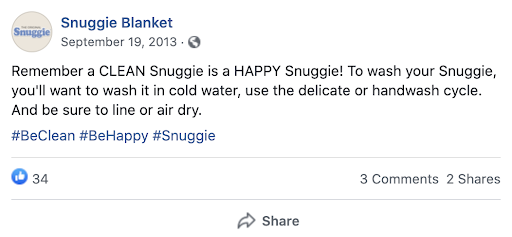It’s nearly fifteen years since you launched the world’s one and only blanket with sleeves: The Snuggie. Thanks to a two-minute infomercial, you managed to sell millions of Snuggies and make millions of profit. (Now that’s ROI on your marketing.)
But you’re not done yet! It’s 2021, and you just released the new and improved Snuggie Sherpa. Retailing more than three times the Classic Snuggie, you could make a killing! So how should you market it?

While infomercials and call-in orders once worked for your marketing strategy, times have changed. The internet plays a much bigger role today—so you need a compelling e-commerce content marketing strategy to match.
What’s a content marketing strategy? It’s the strategy surrounding creating and distributing content to attract and retain your target audience—and ultimately, to drive profitable customer action.
Sounds like something you’ll need to get your Snuggie Sherpa off the ground, hey? So that’s why we’re here today. As part of our Digital Marketing Series, we’re here to walk you through five steps for creating an e-commerce content strategy that’ll help skyrocket your sales.
(And if you don’t have a website up and running just yet, no sweat. Here’s how you can build an e-commerce website from scratch.)
1. Create a Buyer Persona
Before you create any content for your e-commerce business, you need to create buyer personas. These are fictional characters that are meant to represent real people—aka. your customers.
If you follow the Galactic Fed blog, you’ve probably seen us refer to this image before:
These questions are super helpful for creating detailed buyer personas.
Detail is crucial for drilling down your target audience. It’ll separate you from marketers that simply target folks searching for a new blanket. (How vague!)
So consider your customers’:
- Demographic information
- Jobs and salaries
- Pain points and challenges
- Goals and needs
This process reveals who would perk up when seeing your marketing content. (It will subsequently help guide you to what types of content you should create, which we’ll dig into later.)
In the case of the Snuggie Sherpa, consider folks who:
- Enjoy doing activities from the couch (such as reading and watching tv).
- Have a bigger budget. (It retails for $49.99 vs. $14.99 for the Classic.)
- Live in colder regions
From there, you could create their whole life story: Diana is a 40-year woman living in Maine. Once she drops off her two children at school, she spends her days working on her remote copywriting business from home. In her spare time, she enjoys reading fictional novels and watching movies with her family.
In other words, Diana would love the Snuggie Sherpa. So how do you create an e-commerce content strategy that would convert Diana into a customer?
2. Conduct Keyword Research
Keyword research is essential for creating a successful e-commerce content strategy. It’s the process of finding and analyzing queries that people enter into search engines to inform your marketing.
Today, we’ll be explaining why it’s helpful for your content marketing strategy.
Keyword r reveals your customers’ questions, pain points, concerns, and needs. It also reveals their search intent and how they talk about your product. Getting inside their head and speaking their language is incredibly useful for creating effective marketing content. Instead of creating content blindly, you now have clues as to what would hold them back from making a purchase. (And can now proactively address their hesitations.)
Keyword research is pretty easy to do on your own too. Here’s how you can do it without any keyword research tools:
- Hop onto Google and input a query you think Diana would write for herself. For example: “What is the best blanket for reading?”
- Take a look at what Google suggests when you start typing this query. You can also scroll through the results and look at the “People Also Ask” or “Related Searches” sections. These are all popular queries that real people made.
- Look for common threads to inspire content. How are people referring to your product? What are they looking for?
As revealed in the “People Also Ask” section, softness and comfort are two major selling points. While it’s not a surprise, you should be mindful of using these words in your web content to pump up your SEO.
And how can we spin some marketing content out of this keyword research? Let’s take a look.
3. Determine the Best Content Types For Your Audience
Once you identify your target audience and what they’re searching for, brainstorming ideas for your e-commerce content strategy will be a breeze.
Essentially, there are four types of content you can create:
- Copy
- Design
- Video
- Audio
All of these types of content may have a place in your marketing, but it’s important to create them purposefully. For example, video is incredibly effective at engaging online audiences (1200% more successful than other content, in fact.) But it also requires the most time and resources. To reduce wasted time and budget, every piece of content should have a strategy behind it.
That’s where your keyword research comes in. The trends you see can guide your content creation. Here are two scenarios as examples:
Scenario 1: You noticed a ton of inquiries about your product
If you see a lot of search queries that are questions about your product, your content strategy should work to answer these questions. You could create product walkthrough videos and webinars, upload customer success stories, or even generate an FAQ page addressing these specific search queries. (This is a good SEO play as well.)
Let’s say people are asking if your Snuggies are warm. You could produce small video clips of customers raving about how warm they are. Or, if people are asking how to clean them, you could create an FAQ section on your website or even whip up a social media post.

Scenario 2: You’re being compared to competitors
Suppose you notice that many queries are comparing your product with other brands. In that case, you should be creating eye-catching content that can easily address these comparisons—like promotional emails, advertisements, and social media posts.
Let’s say people are comparing your Snuggie to the Slanket. (This is a real thing.) Find your edge and create content that’ll highlight it. If your Snuggie is softer, create content that hammers home this benefit. You don’t need to call out your competitors specifically. A customer testimonial that emphasizes your superior quality would certainly do the trick.
4. Determine the Right Platforms and Channels
With all that Snuggie content under your belt, it’s time to think about where you’ll distribute it. It’s not as cut-and-dry as posting on your owned channels—like your social media accounts, website, blog, and email newsletters. You’ll also want to consider paid channels and earned channels. (Wondering what owned, paid, and earned channels are? Check out this blog post.)
Examples of paid channels are online advertising platforms—like Google and Facebook Ads—and influencers.
Reposts, reviews, shares, or any user-generated content, are examples of earned channels.
Source: Stratwell
Once you lay out all of your options, it’s time to whittle them down. Here’s how.
Choose channels that let your content shine
Some channels are better suited for your content than others, depending on the types you create.
- If you created static designs or videos, they’re best suited for highly visual channels, like social media and ad platforms.
- If you wrote some killer long-form copy, you’d want to publish it on your blog or slice it up to create an email nurture campaign.
- If you filmed a webinar or product tutorial, you might want to upload it to a channel that supports longer videos, like Youtube, or you could slice it up for a social media story.
Choose channels your audience use
A content distribution channel could work wonders for one business and totally flop for another. Why? Because of their audiences. Your audience must use these channels for your content to be seen. (And if your content isn’t seen, it’ll never convert your audience into paying customers.) Tik Tok could be all the rage, but if your audience isn’t on this platform, you shouldn’t incorporate it into your content strategy.
Think back to when we created our buyer persona for Snuggie. As a 40-year mom and solopreneur, Diana probably uses Facebook and LinkedIn over Instagram and TikTok, right? Because she owns her own business, she also likely checks her email often. These are the channels you should prioritize.
5. Create a Content Calendar
You’ve created a buyer persona. (Hey, Diana!) You’ve done the keyword research. You identified the content you want to create and where you want to distribute it. With all your ducks in a row, it’s time to make a content calendar.
Content calendars are essential for:
- Supporting long-term business growth: Content calendars should plan for months ahead, so you can intentionally line up your content with the overall business strategy.
- Creating a balanced strategy: Your content marketing strategy should cover top-of-funnel content, middle-of-funnel content, and bottom-of-funnel content. Why? To drive conversions.
- Keeping you on schedule: Just like in our personal lives, calendars keep us accountable. Write down all your content launches so you can execute on time and stick to a consistent posting schedule.
- Allowing for easy collaboration: A content calendar will act as a source of truth if you’re working with others, internally or externally. This streamlines communication and collaboration. Instead of knocking on your door for answers (and vice versa), they can consult the calendar.
Plus, if you stay organized, you can get much more mileage out of your content and repurpose it across your different channels. Let’s say you write a blog post on “ten activities you could do while wearing a Snuggie.” You could plan promotional posts on social media before you even launch it. You could tease the blog in your next email newsletter. You could create a funny video demonstrating all these activities to re-promote the blog in a month. The options are endless. (If you’re organized.)
Take a look at this video on how to do that.
Turn Your E-Commerce Content Strategy into Sales
If you’ve completed these five steps, you’re on your way to turning those Snuggie Sherpas into dollars. (Yes, that deserves a “raise the roof.”)
Not quite there yet? No problem. Reach out to our team, and we’d be happy to help you get your e-commerce content strategy off the ground.

